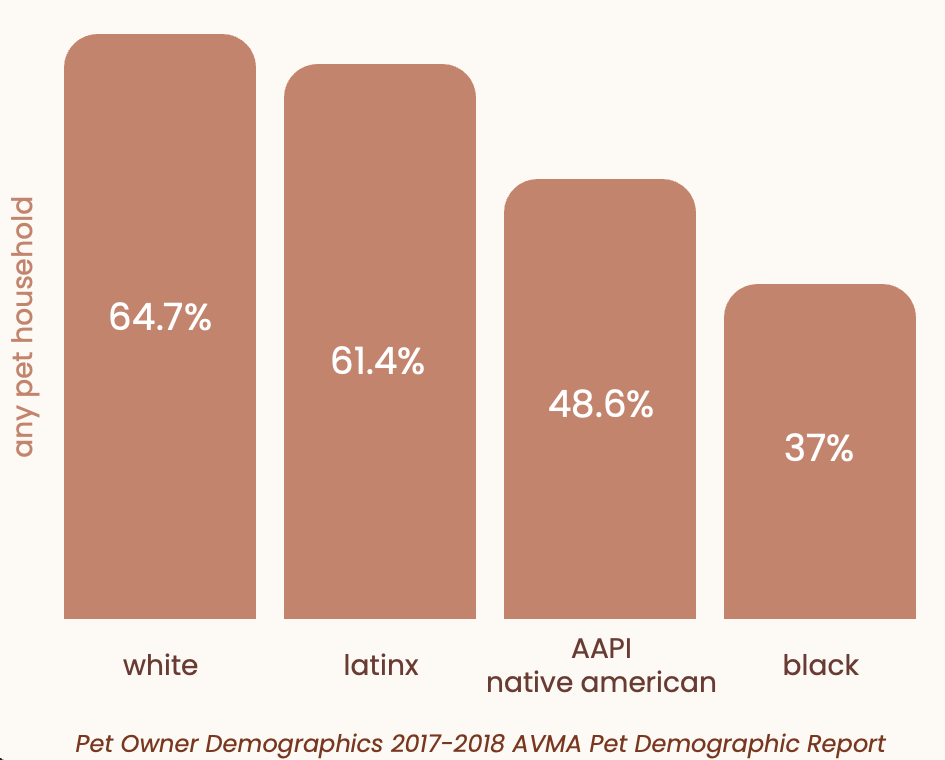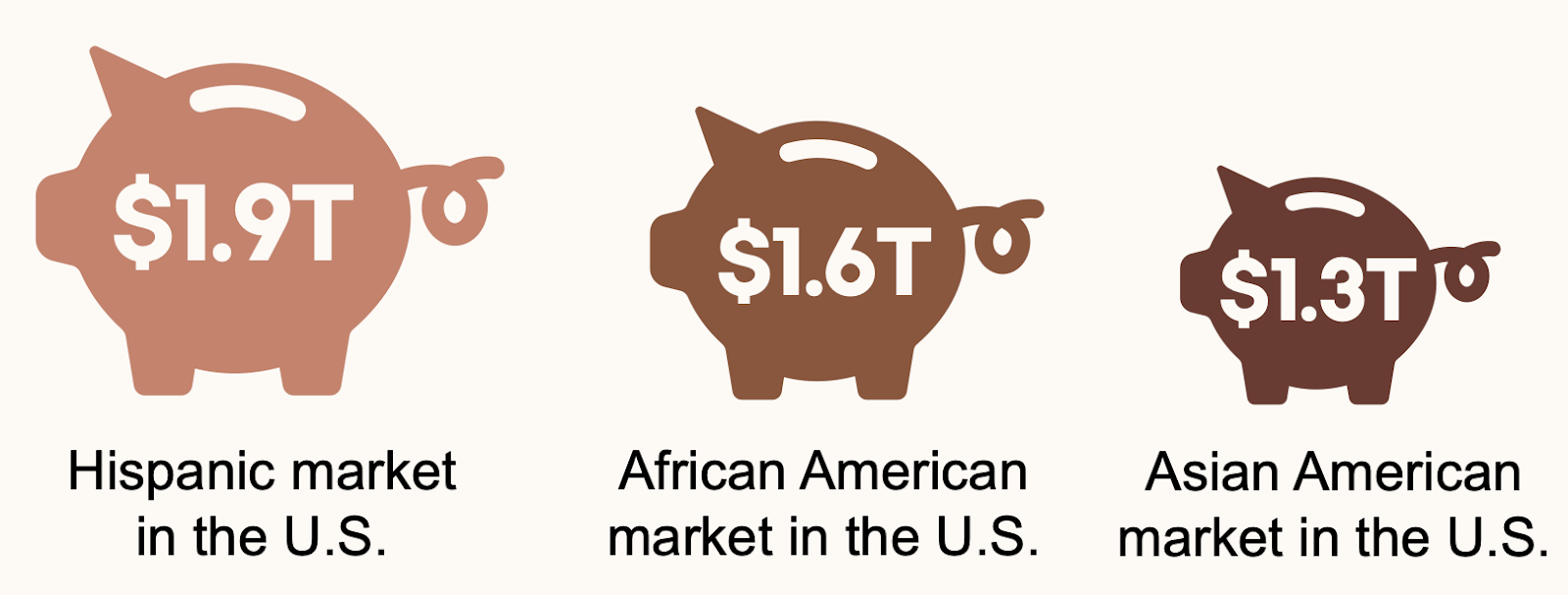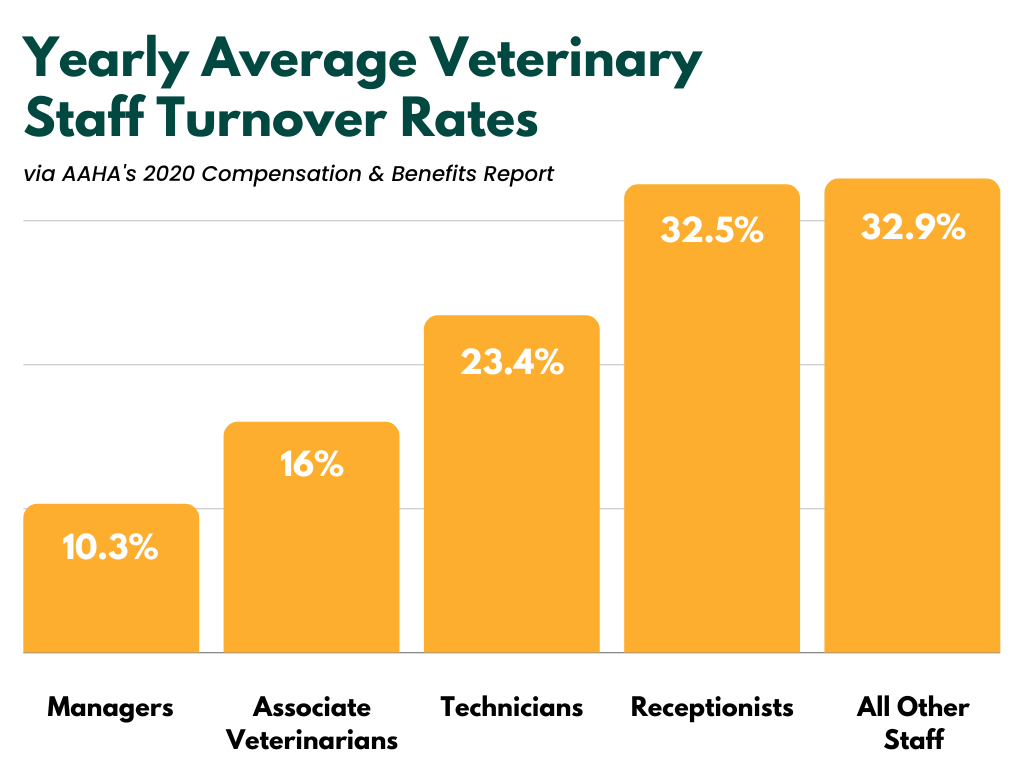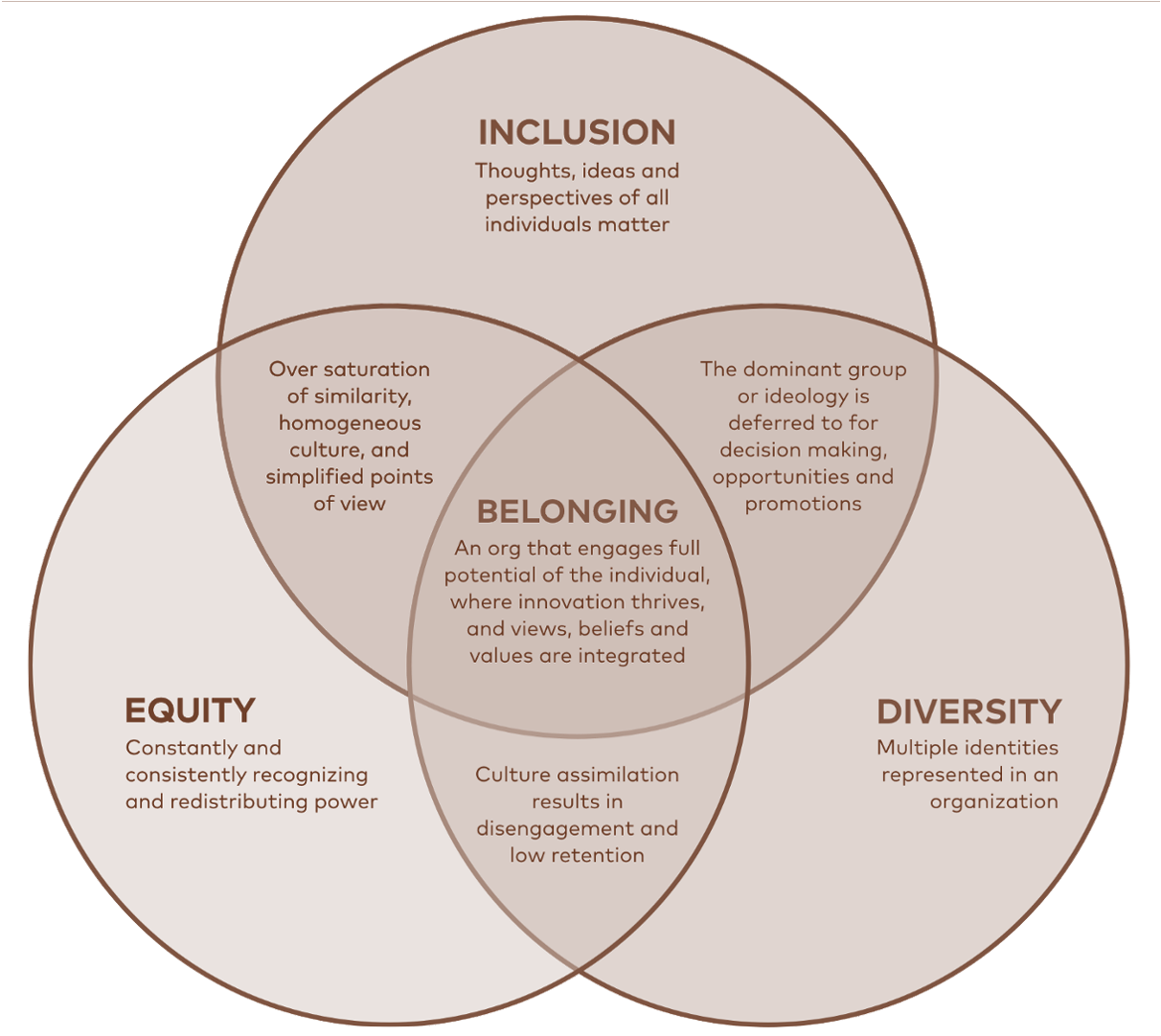table of contents
Why should we care about better belonging in vet med?Lack of diversity in veterinary professionals vs. increased diversity of pet owners
Increased buying power of diverse populations
Lack of retention & increase in recruiting costs
The blendvet framework for DEIB
Being: self-awareness
Building: cultivating strong teams based on trust & open communication
Belonging: encouraging collaboration within their communities
You’ve likely heard the acronym “DEI” before, which stands for Diversity, Equity, and Inclusion. Recently, there’s been a push to include a “B” at the end of the acronym to make the full sentiment be Diversity, Equity, Inclusion, and Belonging (DEIB) — and for good reason.
Diversity, Equity, and Inclusion doesn’t just happen — and belonging takes that a step further — to have diverse voices in the workplace not only seen and heard but recognized and celebrated.
And true belongingness is achieved when underrepresented individuals are comfortable being their authentic selves and speaking up. That’s the difference maker. If you give them a seat at the table, but they don’t feel psychologically safe or comfortable, they won’t speak up.
As leaders in vet med, we must make a concerted effort to ensure our workers of all races, backgrounds, and identities have the opportunity to truly belong in our workplaces.
So, how do we make that happen?
We teamed up with Dr. Niccole Bruno, CEO & Founder of blendvet, an emerging DEIB certification program designed by vet med for vet med, to get a deep-dive on their methodology to give you a comprehensive baseline of what it takes to make your practice a place where everyone can belong.
Quick note: Of course, this guide isn’t a comprehensive guide in DEIB training, nor should it be a replacement for the excellent work done by DEIB professionals. But, it can serve as an excellent baseline for what DEIB training & work can/will look like in your veterinary practice.
Why should we care about better belonging in vet med?
But first, let’s set the scene a bit about why practices should be putting their focus on DEIB.
Lack of diversity in veterinary professionals vs. increased diversity of pet owners
By now, we’ve likely all seen that piece from The Atlantic in 2013 where Veterinarians were the whitest profession in America.
Since then, it has improved, but it’s certainly still not representative of the population of pet owners we serve.
According to the Bureau of Labor Statistics:
- 12% of veterinarians are racially diverse
- 21% of veterinary technicians are racially diverse
- 20% of assistants and pet caretakers are racially diverse
Let’s compare that to pet owners.
The below graph was supplied by blendvet based on the 2017-2018 AVMA Pet Demographic Report:

We clearly still have some work to do to be a truly representative profession.
Why does this matter?
The HABRI-Petco Love survey found 53% of pet owners of color agree that it is important that veterinarians and their staff members reflect the racial/ethnic diversity of the communities they serve.

If pet owners don’t see themselves represented in our practices, they will not feel like they belong there — plain and simple.
Increased buying power of diverse populations
Not only are pet owners diverse, but the buying power of BIPOC communities in the US is skyrocketing.
The below graphic was supplied by blendvet to put a finer point on the buying power in the US:

Why does this matter?
Veterinary practices must also intentionally create environments that foster belongingness and be mindful of where cultural barriers appear in our examination rooms. These differences can erode trust, which is fundamental in the veterinary-client-patient relationship (VCPR), affect patient care and impact our bottom line as business entities.
Lack of retention & increase in recruiting costs
According to AAHA’s Compensation & Benefits report, the average yearly veterinary team turnover rate is 23%.
If we break that number down by position:

Turnover was 10.3% for managers, 16% for associate veterinarians, 23.4% for veterinary technicians, 32.5% for receptionists, and 32.9% for all other staff.
Why does this matter?
Vet med is small, and word of mouth is everything when it comes to practice recruitment. We must be cognizant of fostering a culture of belonging, or attrition, turnover, and recruiting costs will rise.
The blendvet framework for DEIB
Throughout Niccole’s journey in DEIB training and creating blendvet, she realized that it is multifactorial and it’s important that we teach it in the context of:
- Being (our self-awareness of diversity, equity, inclusion, and belonging)
- Building (how do we cultivate teams that are rooted in DEIB in practice)
- Belonging (How do we make sure that people can come to work as their authentic selves AND then create those relationships with our clients and community)
Below, we break down each section and some main areas you’ll want to consider for each.
Being: self-awareness
The first step to creating better belonging in practices is understanding our own relationship with DEIB. Understanding the below concepts helps us relate to one another and have a greater sense of community — all helping to foster a culture of belonging.
What is DEIB?
First, let’s review some definitions in the context of workplaces:
- Diversity: Multiple identities represented in an organization
- Equity: Constantly and consistently recognizing and redistributing power
- Inclusion: Thoughts, ideas, and perspectives of all individuals matter
- Belonging: An org that engages the full potential of the individual, where innovation thrives, and views, beliefs, and values are integrated
So how do these concepts intersect? Below, blendvet provided a graphic that demonstrates this:

Understanding your own intersectional identities
When discussing DEIB, the word “intersectionality” comes up quite frequently.
Intersectionality is a term coined by Kimberly Crenshaw in the 1980s to point out the differences between the lived experience of black men vs. black women. While they may share the same race/ethnicity, they have different experiences in life because of their gender.
People are not one-dimensional, and this intersectionality highlights the interconnected nature of social categorizations such as race, class, and gender as they apply to a given individual or group.
Meaning we are not just our race or our gender in a vacuum. Each person is made up of multiple identities, and how those identities intersect makes up each of us as individuals. Those identities affect how we exist in our society and how much we are accepted and made to feel like we belong.
Resources to dive deeper:
- TED Talks: The urgency of intersectionality
- Disorient: Intersectionality in the Workplace: Creating Justice, Not Diversity
- Power to Fly: Defining Intersectionality: A Guide for the Workplace
- Harvard Business Review: An Intersectional Approach to Inclusion at Work
Understanding unconscious biases
Unconscious bias, also called implicit bias, are social stereotypes about certain groups of people that individuals form outside of their conscious awareness. These biases are not limited to race or ethnicity. While those types of biases are well-documented, biases can exist towards any social group. Someone’s age, gender, gender identity, physical abilities, religion, sexual orientation, weight, and many other characteristics can be subject to bias.
Something important to note is we all have unconscious biases, and the work to unlearn these biases is a constant process.
Resources to dive deeper:
- NPR Short Wave Podcast: Understanding Unconscious Bias
- BuiltIn: Unconscious Bias: 16 Examples and How to Avoid Them in the Workplace
- Harvard Business Review: Unconscious Bias Training That Works
- UCSF: Unconscious Bias Training
Building: cultivating strong teams based on trust & open communication
Once you’ve done the internal work to understand your place in DEIB, the next step toward belonging is building a strong culture in your practice.
Hiring practices
How we hire people directly impacts the diversity, and subsequent belonging, of our team members. Most people have heard of “culture fit,” where they have a few team members interview someone to see if they’ll “fit” into the team culture. Unfortunately, this can lead people to exhibit their affinity bias (which is our tendency to favor people who share similar interests, backgrounds, and experiences with us) and prohibits diversity — both of thought and identity.
An excellent way to re-frame this is by hiring for “culture add.” How will this person add to our already awesome culture? How will they bring new perspectives and life experiences to help us better serve our clientele? What gaps do we have in our team that would help us better serve our community?
Answering those questions instead of looking for someone who “fits” can be a great first step toward more equitable hiring practices.
Resources to dive deeper:
- Forbes: Culture Fit Versus Culture Add: Hiring For Growth
- BetterUp: Cultural fit is being replaced by culture add: Find out why
- Forbes: 11 Steps To Reduce Unconscious Bias In Hiring Processes
- Handshake: How to remove hiring bias from the recruiting process
Creating safe & vulnerable spaces
Once you’ve removed barriers in your hiring practices, you must also create a culture of vulnerability & acceptance. If you hire for “culture add” but do not openly encourage their thoughts, opinions, and life experience, you’ve only cracked the door open instead of welcoming them with open arms.
This will take self-awareness, empathy, and open communication — but it’ll pay dividends in both your employee retention and profits.
Resources to dive deeper:
- Forbes: 15 Ways Your Organization Can Create A Safe Space In A Divisive World
- World of Work Project: Vulnerability In The Workplace: A Leadership Skill
- Hive: How To Create a Safe Space For Your Team
- Hound: Why Psychological Safety Should Be a Core Focus in Your Veterinary Practice
Fostering feedback loops & continual learning
Feedback loops are of the utmost importance in your practice. If you do not receive feedback as much as you give it, you are not fostering those safe spaces you’ve created long-term.
For continual learning, we’re not just discussing creating a CE budget and reminding your people that it’s there once a year. We must proactively encourage and foster a culture of learning — both skills-based and knowledge-based.
Resources to dive deeper:
- Forbes: The Importance Of The Employee Feedback Loop
- Indeed: Creating a Positive Feedback Loop in Your Business (With Examples)
- Hound: Why Team Training is the Key to Veterinary Retention
- Rally: software built by and for vet med to encourage team engagement, feedback, and recognition
Belonging: encouraging collaboration within their communities
Continuing to foster the community you’ve built internally
Once you’ve done the foundational work of understanding your place in DEIB (being) and cultivating a strong team (building), it’s time to ensure those items stick for the long term.
Getting yearly training or reassessing the culture you’ve built on a consistent basis will ensure the work you did to build this culture of belonging sticks.
Often, people think DEIB is a one-and-done process, but it requires maintenance to continue working. As you hire new team members, welcome new clientele, or the socioeconomic climate shifts; it’s important to foster inclusivity in your team by taking inventory of protocols and practices that are working or could be improved upon.
Having input from all team members fosters collaboration and contributes to high performance and profitability in your teams. It’s also important to be aware that the communities we serve are an extension of our veterinary hospitals, and we must ensure our clients feel included too.
Engaging with & being a good steward for your greater community
We must always remember that we serve a community of pet owners. And those pet owners rely on us in some of the hardest and most joyous days of their lives. To truly foster belonging, we must engage with and be good stewards of the communities we serve.
That can look like:
- hosting street clinics
- volunteering at community events
- supporting minority-owned businesses (restaurants, groomers, pet stores, etc.)
- having clear & transparent pricing
- providing multiple options for payment to be inclusive of low-income clients
Building the pathway for future generations
Remember those diversity statistics above?
On top of those statistics, there’s also a veterinary shortage in general, and we must all be part of the solution.
We can change these numbers — and it starts with our youth. Creating pathway programs & shadowing opportunities for children from all backgrounds encourages them to pursue a career in vet med they may not have thought was possible.
Blendvet is leading the way for this in vet med; check out their pathway program and get involved!
DEIB is not transactional; it’s transformational.
The thing about DEIB education and training is that it is a living, breathing process. You will never “finish” getting better and working on belonging.
As we gain new clientele and workers, we must always make a concerted effort to ensure everyone who walks into our practices feel as if they belong.
If you’re interested in learning more about the blendvet program and potentially bringing them to your practices, check out their website at www.blend.vet





